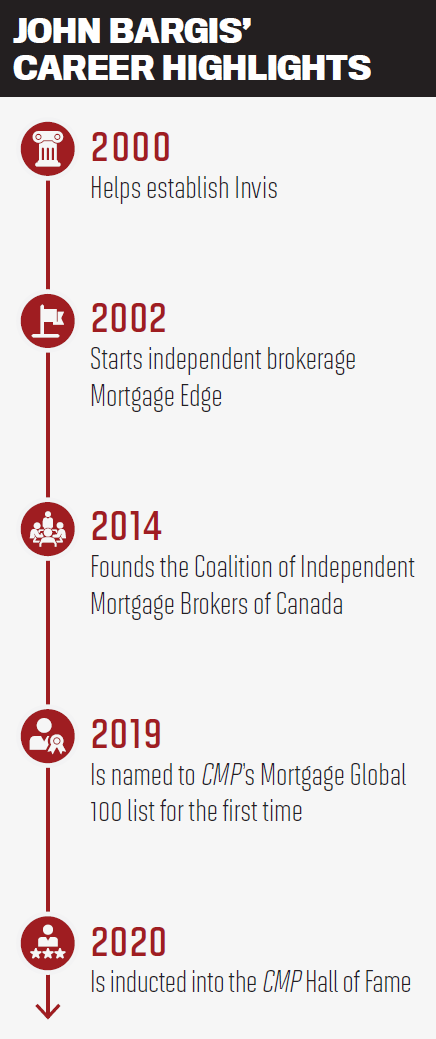CIMBC founder John Bargis tells CMP how his lengthy career as one of Canada's leading mortgage brokers inspired him to form an organization designed to support independent brokers

It may seem surprising now, but industry veteran John Bargis says he never imagined that he would one day have a long and successful career in the broker channel. The catalyst for his move into the space arrived when he was working at TD Bank and met Tina, the woman who would become his life and business partner. This pivotal event encouraged him to explore the industry – and, he says, had a huge bearing on the success he’s achieved since.
It was soon clear that Bargis and the mort-gage industry were a good match; during the first third of his career as an agent, he funded more than $150 million in mortgage volume. He was instrumental in the formation of Invis as a founder and managing partner, a role that arose from the time he spent crisscrossing the country as chair of the association now known as Mortgage Professionals Canada.
Upon the sale of Invis, Bargis decided to return to his roots as an independent broker, starting the Mortgage Edge brokerage with Tina – with a clear vision in mind for what he wanted the company to represent.
“Our main focus while building the company was to stay the course on a number of key initiatives: direct access to lenders based on performance, education on the importance of increased productivity, addressing lender sensitivities under a true partnership model, teaching the importance of a strong process and structure and how to properly mine business, to name a few – and all this with no compromise to compensation,” he says.
It was an approach that was geared around the idea of running the business rather than letting the business run its agents, Bargis adds. “After all, time is money regardless of what business one is in.”
Independent spirit
Bargis’ extensive experience as a leader and entrepreneur in the mortgage industry eventually led him to form the Coalition of Independent Mortgage Brokers of Canada (CIMBC). The organization’s genesis, Bargis says, was the result of considerable time spent closely watching the evolution of the mortgage space.
“I explored the idea of creating a national collective of independents that, while maintaining the integrity of a true independent broker model, would also offer the bene-fits and strength of a cooperative structure on a national scale,” he says. “I didn’t really have to look far beyond what we had already successfully built under our own brokerage to find the answers.”
CIMBC’s initial objectives were clear, Bargis says: Each member broker had to maintain their true independence and lone brand recognition, with no interference in any way on each member’s operations.
Not charging monthly network or franchise fees was also a critical point for Bargis, who wanted to prioritize “direct, unfettered access to lender partners” and a focus on increasing the productivity and profitability of broker partners and agents. It’s an approach that has served the organization well.
“We’re very pleased with our growth and progress since our formation,” he says. “Although CIMBC has grown to north of 90 member broker partners nationally with over $12 billion in originations, we have a great five-year plan in place that continues to evolve for the benefit of the feet on the street, first and foremost.”
The future of brokering
Coming down the line, Bargis foresees an increase in new lenders entering the market, as well as the continued growth of technology “in a positive way as it relates to the origination process and quality.”
On the regulatory front, Bargis points to positive changes that have taken place, describing them as “welcome and encouraging” developments in helping push the industry forward and continuing to professionalize the broker channel.
“The jurisdictional governments are themselves going through a transformation in a good way as our industry continues to grow,” he says, “and I applaud their efforts and approach of embracing industry stakeholders for their input and feedback.”
 Of course, underlying those positive changes has been a market infused with an unprecedented level of unpredictability and volatility. While Bargis believes there may be some bumps in the road ahead, he sounds an optimistic note on any economic repercussions that Canadians might face.
Of course, underlying those positive changes has been a market infused with an unprecedented level of unpredictability and volatility. While Bargis believes there may be some bumps in the road ahead, he sounds an optimistic note on any economic repercussions that Canadians might face.
“The one cautionary point I’ll make is that there may well be a market correction to an unknown extent as a result of the imminent rate hikes in an effort to curb the not-so-transitory inflationary pressures,” he says. “The good news is that record savings resulted from the pandemic, which may well serve as a support mechanism to shore up any unforeseen financial challenges for many Canadians.”
It’s little surprise that Bargis is so bullish on the future of the mortgage market and the broker channel, given that he’s had the opportunity to witness the profound trans-formation of the industry throughout his lengthy career. The changes he’s seen since starting his journey in the mortgage industry have been “nothing short of positive,” Bargis says. The share of mortgages orchestrated by brokers has risen significantly in recent years – particularly since the onset of the COVID-19 pandemic – and that growth appears likely to continue in the coming years.
“If there’s any concern about the resilience of the broker industry,” he says, “rest assured it’s here to stay for the foreseeable future.”



